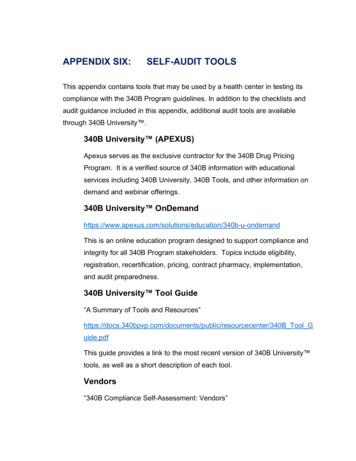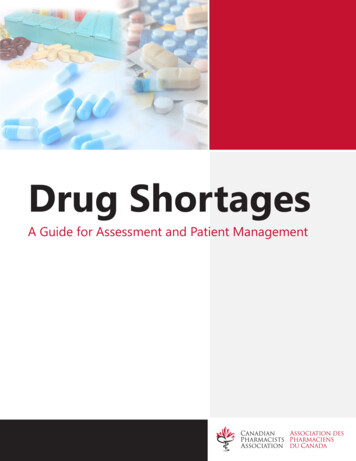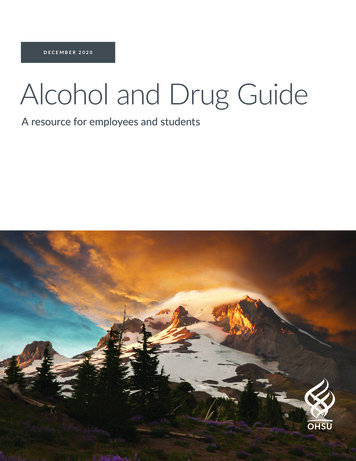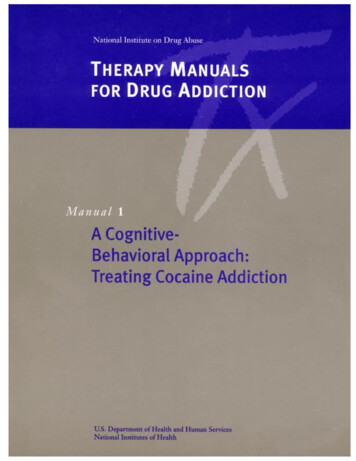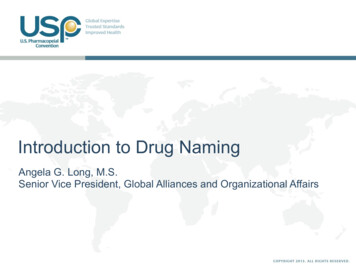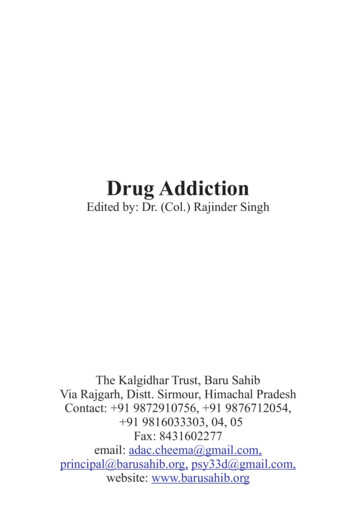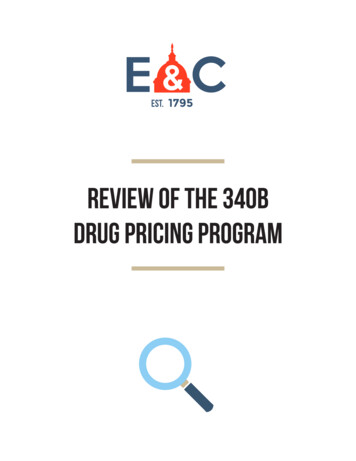
Transcription
Review of the 340BDrug Pricing Program
Table of ContentsI.Executive Summary. 2II. Table of Acronyms . 6III. Findings . 7IV. Background . 9A. Overview of the 340B Program’s Development and Growth . 9B. Types of Covered Entities . 13C. Background on the Committee’s Investigation. 15D. GAO and HHS OIG Reports on the 340B Program . 18V. HRSA Administration and Oversight of the 340B Program . 20A. HRSA’s Implementation of 340B Regulations. 20B. HRSA’s Authority to Clarify Program Requirements . 25C. HRSA’s Audits of Covered Entities . 30i.Audit Findings . 35ii.Duplicate Discounts . 36iii. Diversion . 38iv. Incorrect Reporting . 40v.GPO Prohibition and Program Termination . 40D. HRSA’s Audits of Manufacturers . 42E. Program Growth and HRSA’s Ability to Keep Up . 43VI. Covered Entity Use of the 340B Program . 48A. Congressional Intent of the 340B Program . 48B. 340B Program Savings . 51i.Restrictions on the Use of Program Savings by Covered Entities . 51ii.Calculation and Tracking of 340B Savings . 53iii. Requirements for HRSA Grantees . 56C. Charity Care Provided by Covered Entities . 57D. Medicare Part B and the 340B Program . 65E. Consolidation of Oncology Clinics . 66F.Disproportionate Share Hospital Metric and Covered Entity Eligibility . 70VII. Conclusion . 75VIII. Recommendations . 76IX. Appendix . 781
I.Executive SummaryThe 340B Drug Pricing Program (340B program) was established by Congress in 1992,and mandates that, to remain eligible for participation in the Medicaid program, drugmanufacturers must provide outpatient drugs to eligible health care providers—also known ascovered entities—at reduced prices. Covered entities include certain nonprofit organizationssuch as qualifying hospitals and federal grantees identified in the Public Health Services Act(PHSA). The Health Resources and Services Administration (HRSA) is the Operating Divisionwithin the U.S. Department of Health and Human Services (HHS) that administers and overseesthe 340B program.The 340B program is an important program that enjoys strong bipartisan support inCongress. The program helps reduce the prices of covered drugs for certain participating entitieswho, in turn, provide care for patients. Numerous covered entities have stated the 340B programhas helped ensure that underserved and indigent patients have access to affordable medicines andhealth care. On numerous occasions, including during the Energy and Commerce Committee’s(the committee’s) most recent hearing in October 2017, the committee has emphasized theimportance of the 340B program in providing care to vulnerable Americans.1Over the past 25 years, the nation’s health care system has changed in some significantways. For example, in 1992, there were roughly 29 million people enrolled in Medicaid and theprogram spent 120 billion that year. Comparatively, in 2016, there were more than 72 millionpeople enrolled in Medicaid and the program cost more than 575 billion.2 In that same period,the 340B program has also grown substantially—not only in the number of covered entities andcontract pharmacies, but also in the amount of money saved by covered entities. HRSAestimates that covered entities saved approximately 6 billion on approximately 12 billion indiscounted purchases in Calendar Year (CY) 2015 by participating in the 340B program.3 It isestimated that discounted drug purchases made by covered entities under the 340B programtotaled more than 16 billion in 2016—a more than 30 percent increase in 340B programpurchases in just one year.4The committee has been examining the operation and oversight of the 340B programover the past two years. Through stakeholder meetings, hearings, and document requests, thecommittee has identified several weaknesses in program administration and oversight.1Examining How Covered Entities Utilize the 340B Drug Pricing Program: Hearing Before the Subcomm. onOversight and Investigations of the H. Comm. on Energy and Commerce, 115th Cong., Preliminary Transcript, at84 (Oct. 11, 2017).2Medicaid and CHIP Payment and Access Commission, MACStats: Medicaid and CHIP Data Book, Exhibit 10(Dec. 2017), available at MACStats-Medicaid-and-CHIPData-Book December-2017.pdf.3340B Drug Pricing Program Ceiling Price and Manufacturer Civil Monetary Penalties Regulation, 82 Fed. Reg.1210, 1227 (Jan. 5, 2017).4Aaron Vandervelde and Eleanor Blalock, Measuring the Relative Size of the 340B Program: 2012-2017,BERKELEY RESEARCH GROUP (July 2017), available athttps://www.thinkbrg.com/media/publication/928 Vandervelde Measuring340Bsize-July-2017 WEB FINAL.pdf.2
Congress did not clearly identify the intent of the program and did not identify clearparameters, leaving the statute silent on many important program requirements. According tothe 1992 House Report accompanying the legislation, the 340B program was intended “to enable[covered] entities to stretch scarce Federal resources as far as possible, reaching more eligiblepatients and providing more comprehensive services.”5 It is unclear whether Congress intendedlow-income and uninsured individuals to directly benefit from the reduced drug prices offeredunder the 340B program. Congress should clarify the intent of the 340B program and, in doingso, evaluate how developments in the health care landscape over the past 25 years have affected,if at all, the structure and goals of the 340B program.HRSA lacks sufficient regulatory authority to adequately oversee the program and clarifyprogram requirements. In 2014, a federal court ruled that HRSA’s regulatory authority is limitedto three specific areas, including (1) establishing and implementing a binding AdministrativeDispute Resolution (ADR) process for the resolution of certain disputes relating to compliancewith 340B program requirements, (2) providing for the imposition of civil monetary penalties(CMPs) against manufacturers that knowingly and intentionally overcharge a covered entity for a340B drug, and (3) issuing precisely defined standards of methodology for calculation of 340Bceiling prices. As a result, HRSA is unable to issue rules that would clarify certain programrequirements. In addition, HRSA has not fully implemented guidance or regulations in the threeareas where the agency has regulatory authority, nor has HRSA issued guidance on fundamentalaspects of the program such as the definition of an eligible patient. Consequently, importantaspects of the program have remained vague, as the statute is silent on many key aspects of theprogram, resulting in variation in the way covered entities use the program. HRSA shouldfinalize regulations in the areas in which it has regulatory authority, and Congress should provideHRSA with more regulatory authority to adequately administer and oversee the 340B program,including the ability to improve program integrity, clarify program requirements, monitor andtrack program use, and ensure that low-income and uninsured patients directly benefit from the340B program.HRSA’s primary compliance mechanism is the agency’s annual audit process. HRSAbegan auditing covered entities in 2012. HRSA conducted 51, 94, and 99 audits in the first threeyears of auditing, and since 2015 has conducted approximately 200 audits annually. HRSA’sannual audits uncovered a high level of non-compliance by covered entities. Given HRSA’slimited authority, HRSA only conducts a limited review of the covered entity’s use of theprogram during the audit process. Specifically, HRSA audits entities only for programeligibility, duplicate discounts, diversion to ineligible patients and facilities, and incorrectdatabase reporting. HRSA also conducts audits of manufacturers to determine whether they areoffering drugs at prices no higher than the 340B ceiling price.The Patient Protection and Affordable Care Act (PPACA) dramatically increased the sizeand scope of this program by expanding eligibility to more types of hospitals, such as criticalaccess hospitals and sole community hospitals, and expanded Medicaid eligibility. Programparticipation has more than quadrupled over the past decade. While HRSA’s authorities andresources have increased over the same period, they do not appear sufficient to meet the demandsof this program. Although HRSA has increased the number of covered entity audits it conducts5H.R. Rep. 102-384, Pt. 2 (1992).3
per year, the percentage of covered entities audited in 2016 was below two percent of totalentities participating in the program. Program growth has outpaced HRSA’s ability toeffectively oversee the program. Congress should equip HRSA with the resources and staffnecessary to conduct more rigorous oversight of the program. In addition, Congress shouldconsider whether the permissible scope of HRSA’s audits should be expanded, and HRSAshould work toward auditing covered entities and manufacturers at approximately the same rate.To further aid HRSA in its administration of the program, Congress should require certaincovered entities to conduct independent audits of program compliance, including of any contractpharmacies.The 340B statute does not require covered entities to track or report program savings orhow they are used. As a result, covered entities use program savings in a variety of ways. Whilesome covered entities (i.e., federal grantees) are restricted in the way they can use program fundsdue to other federal grant requirements, most entities are not required to use program savings inany specific way. Further, the 340B statute does not require covered entities to report the levelof charity care that they provide to patients. The absence of reporting requirements in the 340Bstatute has resulted in a lack of data and transparency on how covered entities use the programand the value of the program, both to entities themselves and to the patients these entities serve.The term “340B savings” refers to the cost saved by the covered entity by purchasing adrug at a reduced price. Because covered entities can purchase medicines at 340B prices forpatients that have insurance, entities can also use the program to generate “340B revenue” bycollecting insurance payments that exceed the acquisition price paid by the covered entity underthe 340B program. Examples of ways a covered entity may maximize its 340B revenue includeprescribing expensive drugs purchased at a significantly discounted 340B price and thenreceiving a higher insurance reimbursement rate for the drug, or hospitals acquiring privateoncology clinics that prescribe expensive oncology drugs and then increasing the cost of care forthe patient through facility fees, even though the treatment that the patient receives has notchanged. Committee staff also heard directly from doctors and administrators about how someunintended consequences of the 340B program may negatively impact the quality of patient care.In the committee’s opinion, increasing transparency in the 340B program would allow foran accurate accounting of the full scope of the program’s use and benefits. Congress, or HRSAwhere HRSA already has authority to make such changes, should promote transparency in the340B program, including by ensuring that covered entities and other relevant stakeholders haveaccess to ceiling prices and requiring covered entities to disclose information about annual 340Bprogram savings and/or revenue. Congress should also establish a mechanism to monitor thelevel of charity care provided by covered entities. This should include a clear definition ofcharity care such that the data can be used to fairly compare care provided across entities.While the 340B program only applies to certain outpatient drugs, eligibility is determinedby using an inpatient metric. The current metric used to determine hospital eligibility for the340B program does not necessarily reflect the amount of charity care offered by the hospital orthe 340B patient population for the hospital. Congress should consider whether an inpatientmetric remains an appropriate measure for program eligibility, or whether another metric is moreappropriate.4
The report concludes with a series of recommendations that, in the opinion of thecommittee, would improve the administration of the 340B program, primarily through changes inHRSA’s regulatory authority and requiring transparency and accountability from coveredentities. If implemented, these changes would strengthen the 340B program.5
II.Table of EHSFFSFTEFQHCFYGAOGPOHHSHHS ive Dispute ResolutionAverage Manufacturer PriceAdvanced Notice of Proposed RulemakingCorrective Action PlanCook Area Health ServicesCivil Monetary PenaltyCenters for Medicare and Medicaid ServicesCommunity Oncology AllianceCalendar YearDisproportionate Share HospitalErlanger Pharmacies Inc.Erlanger Health SystemFee-For-ServiceFull Time EmployeesFederally Qualified Health CentersFiscal YearU.S. Government Accountability OfficeGroup Purchasing OrganizationU.S. Department of Health and Human ServicesOffice of Inspector General. U.S. Department of Health and Human ServicesHuman Immunodeficiency Virus/Acquired Immunodeficiency SyndromeHealth Resources and Services Administration, U.S. Department of Healthand Human ServicesInformation TechnologyJohns Hopkins HospitalLicensed Practical NursesManaged Care OrganizationMedicare Payment Advisory CommissionMedicaid Exclusion FileNational Provider IdentifierNotice of Proposed RulemakingNYU Langone HealthOffice of Pharmacy Affairs, Health Resources and Services Administration,U.S. Department of Health and Human ServicesOffice of Pharmacy Affairs Information SystemPharmaceutical Pricing AgreementPublic Health Services ActPatient Protection and Affordable Care ActRegistered NurseSupplemental Security IncomeUnit Rebate AmountWholesale Acquisition Cost6
III.Findings HRSA has started, but after several years not completed, the process to issue and enforceregulations pertaining to the Administrative Dispute Resolution Process, the calculation ofceiling prices, and manufacturer civil monetary penalties. HRSA has not fully implementedthese regulations in a timely manner. HRSA lacks sufficient authority to adequately oversee the program and clarify programrequirements. HRSA needs more regulatory authority to promote compliance and ensureprogram integrity. Key aspects of the program have remained vague, resulting in variation inthe way covered entities use the 340B program. Although HRSA has increased the number of covered entity audits it conducts per year, theaudit process still needs improvement. Given HRSA’s limited regulatory authority over the340B program, HRSA only conducts a limited review of the covered entity’s use of theprogram during the audit process. Covered entities would benefit from clearer guidance onthe audit process. HRSA’s annual audits uncovered a high level of non-compliance by covered entities. TheHRSA audits from FY 2012 to FY 2016 demonstrate that non-complying entities violateprogram requirements in a variety of different ways, including duplicate discounts, diversionto ineligible patients and facilities, incorrect database reporting, and violation of the GroupPurchasing Organization (GPO) prohibition (if applicable). HRSA audits manufacturers and in their audits to date found no manufacturers out ofcompliance with the statute. However, without access to ceiling prices, covered entities maynot know that they should report to HRSA that they are not getting an accurate price. The PPACA significantly increased the scope of the Medicaid program by expandingeligibility to certain low-income, non-disabled, non-elderly, non-pregnant adults. Medicaidexpansion under the PPACA has likely increased the number of hospitals eligible for the340B program because some hospitals’ eligibility is based, in part, on the number of thehospital’s inpatients who are Medicaid and low-income Medicare patients by virtue of theirDSH (disproportionate share hospital) percentage. Overall, program participation has morethan quadrupled over the past decade. HRSA’s limited oversight ability does not appear tobe sufficient to conduct adequate oversight of this program. Congress did not clearly identify its intent for the program and did not clearly identify theprogram’s parameters, leaving the statute silent on many important program requirements.Moreover, given the vastly changed health care landscape and 340B program environment, itis unclear whether, and to what degree, the program’s original structure is still relevant. Congress did not establish any mechanisms to monitor or calculate program savings orspecify how they are used. As a result, covered entities use program savings in a variety ofdifferent ways. Some covered entities are restricted in the way they can use program fundsdue to other federal grant requirements.7
The 340B statute does not require covered entities to report the level of charity care provided.As a result, there is a lack of data on how much charity care is provided by covered entities.Further, because there is no universally accepted definition of charity care, drawing a faircomparison of charity care provided across covered entities is difficult, if not impossible.Finally, while charity care spending often exceeds program savings, charity care levels havebeen on the decline at some hospitals, even as program savings increase. There is a financial incentive for 340B hospitals to prescribe more, and/or more expensivedrugs to Medicare Part B beneficiaries, and prescribing trends indicate that 340B hospitals doprescribe more and more expensive drugs to Medicare Part B beneficiaries as compared tonon-340B hospitals. There has been a marked increase in consolidation of private oncology practices, which, insome instances, negatively impacts the quality of patient care and can result in increasedpatient cost. The current metric used to determine hospital eligibility for the 340B program does notnecessarily reflect the amount of charity care offered by the hospital or the outpatientpopulation for the hospital. Hospitals have a financial incentive to open child sites in areasthat do not reflect the DSH percentage of the parent entity, thus enabling the hospital to gainaccess to a higher number of commercially insured patients.8
IV.BackgroundA. Overview of the 340B Program’s Development and GrowthCongress established the 340B Drug Pricing Program (340B program) through theVeterans Health Care Act of 1992.6 The 340B program mandates that, to remain eligible forparticipation in the Medicaid program, drug manufacturers provide covered outpatient drugs toeligible health care providers at reduced prices.7 More specifically, the statute requires that, as acondition of participation in the Medicaid program, drug manufacturers enter into pharmaceuticalpricing agreements (PPAs) that require those manufacturers to sell their product at a discount tocertain health care providers, known as covered entities.8 Covered entities include certainnonprofit organizations such as qualifying hospitals and federal grantees identified in the PublicHealth Services Act (PHSA).9According to the 1992 House Report accompanying the original legislation, the 340Bprogram was established, in part, to respond to the increase in prescription drug prices for theDepartment of Veterans Affairs and some federally-funded clinics and public hospitals followingthe enactment of the 1990 Medicaid Drug Rebate Program (created through the Omnibus BudgetReconciliation Act of 1990 (OBRA)).10 Before the enactment OBRA, many drug manufacturersvoluntarily sold medicines to the Veterans Health Administration and other federal entities(including public health service grantees) at significant discounts and drug manufacturers alsobargained with large purchasers.11 Because the Medicaid Drug Rebate Program requires thatpharmaceutical manufacturers provide Medicaid with the manufacturers’ lowest or “best price”for outpatient drugs, some stakeholders were concerned that after the program was implemented,manufacturers might limit discounts to federal, non-Medicaid purchasers. The 1992 HouseReport indicated that, “[i]n giving these ‘covered entities’ access to price reductions thecommittee intends to enable these entities to stretch scarce [f]ederal resources as far as possible,reaching more eligible patients and providing more comprehensive services.”12 Beyond thesestatements in the 1992 House Report, it is unclear exactly how Congress intended coveredentities to use the 340B program. Congress remained silent in the statute on many importantquestions regarding the structure and scope of the 340B program.6Veterans Health Care Act of 1992 (VHCA), P.L. 102-585.The definition of a covered outpatient drug is set forth in section 1927(k) of the Social Security Act. According toApexus, the 340B program generally includes the following outpatient drugs: (1) FDA-approved prescriptiondrugs; (2) Over-the-counter (OTC) drugs written on a prescription; (3) biological products that can be dispensedonly by a prescription (other than vaccines); or (4) FDA-approved insulin. Apexus, 340B Price/CoveredOutpatient Drugs (last accessed Jan. 3, 2018), pricing-covered-outpatient-drugs.8Public Health Service Act, 42 U.S.C. 256b. A sample 340B program Pharmaceutical Pricing Agreement isavailable on HRSA’s website. See U.S. Dep’t of Health and Human Services, Health Services and ResourcesAdministration, General Instructions for Completing the Pharmaceutical Pricing Agreement (PPA) (last accessedJan. 3, 2018), acturers/pharmaceuticalpricingagreement.pdf.9See Health Resources and Services Administration, 340B Eligibility & Registration (last accessed Dec. 1, istration/index.html.10H.R. Rep. 102-384, Pt. 2 (1992).11U.S. Senate, Committee on Labor and Human Resources, Hearing on Public Health Clinic PrudentPharmaceutical Purchasing Act (S. 1729) (Oct. 16, 1991) (statement of Stephen Schondelmeyer, Pharm.D., Ph.D.).12H.R. Rep. 102-384, Pt. 2 (1992).79
The 340B program is an important program that helps reduce the prices of covered drugsfor certain participating entities who, in turn, provide care for patients. On numerous occasions,including during the committee’s most recent hearing in October 2017, the committee hasemphasized the importance of the 340B program in further enabling covered entities to providecare to vulnerable Americans.13The Health Resources and Services Administration (HRSA) is the Operating Divisionwithin the U.S. Department of Health and Human Services (HHS) that administers and overseesthe 340B program. According to HRSA’s Fiscal Year (FY) 2018 Budget Justification, HRSAbudgeted 10.2 million and 22 Full Time Employees (FTEs) to administer the 340B program inFY 2017.14 HRSA and manufacturers have had the authority to audit covered entities since the340B program was established in 1992.15 Initially, however, HRSA primarily relied on coveredentities to self-monitor and ensure compliance with 340B program requirements.16 In 2012,following a 2011 Government Accountability Office (GAO) report recommending HRSA beginauditing covered entities to monitor for program violations, provide additional programoversight, and prevent diversion and duplicate discounts, HRSA began conducting selectiveaudits of covered entities.17 HRSA also conducts audits of manufacturers to ensure compliancewith program requirements.18Participation in the 340B program is voluntary for covered entities and drugmanufacturers, but there are incentives to participate. Participating manufacturers remaineligible for the Medicaid program, meaning that their pharmaceuticals are covered by Medicaid.Covered entities are eligible to receive discounts on certain outpatient prescription drugs fromparticipating manufacturers and save between 25 and 50 percent of the average wholesale pricefor covered outpatient drugs.19 The 340B price for a drug paid by covered entities—sometimesreferred to as the 340B ceiling price—is based on a statutory formula and represents the highestprice a drug manufacturer may charge covered entities.20 HRSA calculates the ceiling price foreach 340B drug as the difference between the drug’s average manufacturer price (AMP) and itsunit rebate amount (URA), obtaining both the AMP and URA from the Centers for Medicare andMedicaid Services (CMS) as part of quarterly reporting for the Medicaid Drug Rebate13Examining How Covered Entities Utilize the 340B Drug Pricing Program: Hearing Before the Subcomm. onOversight and Investigations of the H. Comm. on Energy and Commerce, 115th Cong. (Oct. 11, 2017).14U.S. Dep’t of Health and Human Services, Health Resources and Services Administration, Fiscal Year (FY) 2018Justification of Estimates for Appropriations Committees, at 244 (2018).15U.S. Dep’t of Health and Human Services, Health Resources and Services Administration, 340B Drug PricingProgram Notice: Clarification of HRSA Audits of 340B Covered Entities, Release No. 2012-1 (Mar. 5, tion030512.pdf.16Examining the 340B Drug Pricing Program: Hearing Before the Subcomm. on Health of the H. Comm. onEnergy and Commerce, 114th Cong., at 19 (Mar. 24, 2015).17Id.18U.S. Dep’t of Health and Human Services, Health Resources and Services Administration, FY 2017Manufacturer Audit Results (last updated Dec. 12, 2017), sults/fy-17-manufacturer-audit-results.html.19340B Prime Vendor Program, 340B Price/Covered Outpatient Drugs (last accessed Dec. 1, 2017), available rs may sell a drug at a price that is lower than the ceiling price, so covered entities may negotiateprices below the ceiling price.10
Program.21 AMP is defined as the average price paid to manufacturers by wholesalers for drugsdistributed to retail community pharmacies and retail community pharmacies that purchase drugsdirectly from the manufacturer.22 The URA is based on the formula used to calculate Medicaiddrug rebates as specified in Section 1927 of the Social Security Act.23 Currently, the MedicaidDrug Rebate Program rebate is 23.1 percent for single-source and innovator drugs and 13 percentfor generic drugs. Occasionally, the formula results in a negative price for a 340B drug. In thesecases, HRSA has instructed manufacturers to set the price for that drug at a penny for thatquarter—referred to as HRSA’s penny pricing policy.24Covered entities do not receive discounts on inpatient drugs under the 340B program, butcan realize substantial savings through 340B price discounts and generate 340B revenue byselling eligible outpatient drugs at a higher price than the discounted price at which the coveredentity obtained the drug. Moreover, while covered entities are prohibited from diverting anydrug purchased at a 340B price to an individual who does not meet HRSA’s current defini
The 340B Drug Pricing Program (340B program) was established by Congress in 1992, and mandates that, to remain eligible for participation in the Medicaid program, drug . Data-Book_December-2017.pdf. 3 340B Drug Pricing Program Ceiling Price and Manufacturer Civil Monetary Penalties Regulation, 82 Fed. Reg. 1210, 1227 (Jan. 5, 2017).

